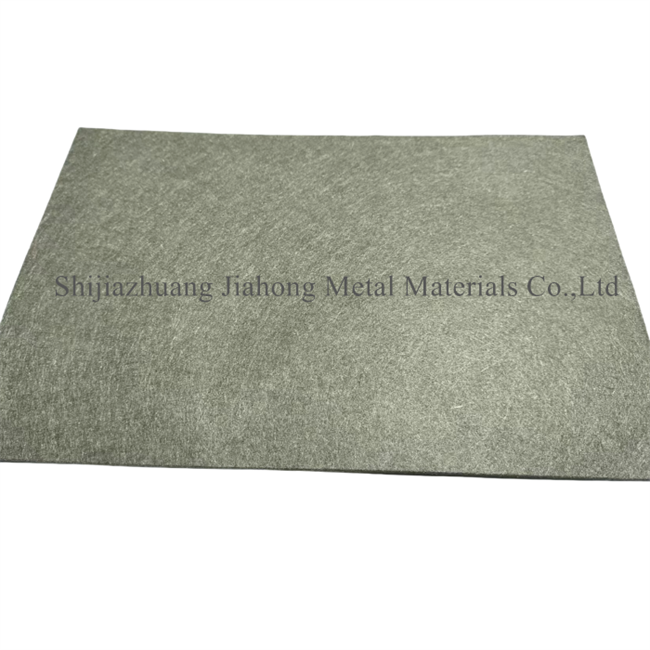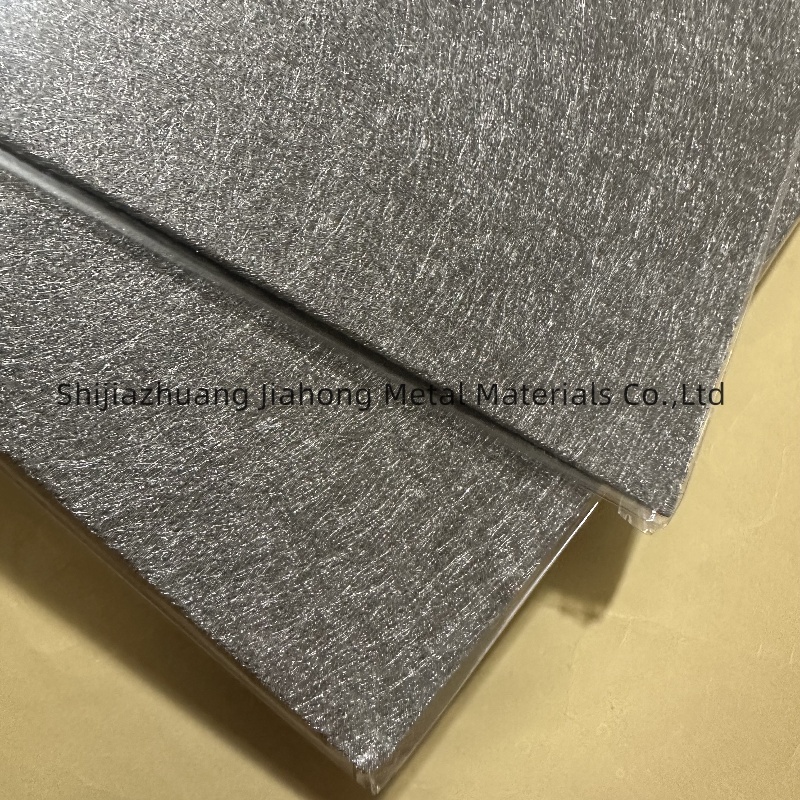Nickel Fiber Felt for Hydrogen Electrolyzers | AEM Gas Diffusion Layer Ni Paper Felts
Nickel Fiber Felt: Powering Green Hydrogen Production As a critical component in hydrogen electrolyzers, nickel fiber felt serves as an advanced gas diffusion layer (GDL) for efficient water splitting. Its high porosity, corrosion resistance, and electrical conductivity make it indispensable for next-generation hydrogen energy systems. At Jiahong Metal, we engineer nickel fiber felts to optimize electrolyzer efficiency and durability, supporting global decarbonization goals.
Description
Nickel Fiber Felt in Hydrogen Electrolyzers
Role as Gas Diffusion Layer (GDL)
- Enhanced Mass Transfer: 3D porous structure (80-95% porosity) ensures uniform gas/liquid flow, reducing voltage drop.
- High Current Density Support: Stable performance under >2 A/cm², critical for industrial-scale electrolysis.
- Corrosion Resistance: Withstands acidic/alkaline electrolytes (pH 1-14), prolonging electrolyzer lifespan.
Key Material Parameters
1. Optimized Physical & Chemical Properties
| Parameter | Specifications | Industry Impact |
|---|---|---|
| Porosity | 50-95% (adjustable) | Facilitates rapid gas/liquid diffusion, reducing voltage losses. |
| Fiber Diameter | 5-20 μm (controlled distribution) | Balances mechanical strength and surface area for catalysis. |
| Thickness | 0.5-3.0 mm (customizable) | Adapts to compact electrolyzer stack designs. |
| Electrical Conductivity | >500 S/cm (at 25°C) | Minimizes interfacial resistance for high current density (>2 A/cm²). |
| Thermal Stability | Stable up to 800°C (in inert atmosphere) | Compatible with SOEC high-temperature operations. |
| Corrosion Resistance | pH 1-14 (acid/alkali environments) | 20,000+ hours lifespan in PEM/AWE electrolyzers. |
How Nickel Fiber Felts Work Inside Hydrogen Electrolyzers
1. Role in PEM Electrolyzers (Proton Exchange Membrane)
- Location: Sandwiched between the catalyst-coated membrane (CCM) and bipolar plates.
- Core Functions:
- Gas Diffusion: 3D porous structure ensures uniform H₂/O₂ distribution, preventing bubble coalescence (target pore size: 50-200 μm).
- Electron Conduction: Directly transfers electrons from the catalyst layer to the current collector.
- Water Management: Hydrophilic/hydrophobic treatment options regulate water retention for stable membrane hydration.
2. Application in Alkaline Water Electrolyzers (ALK)
- Replaces Titanium Meshes: Nickel fiber felts reduce material costs by 40% while maintaining performance in 30% KOH solutions.
- Structure:
- Anode Side: Nickel felt with IrO₂ coating (overpotential <300 mV @ 1 A/cm²).
- Cathode Side: Nickel felt with Ni-Mo alloy coating for HER (hydrogen evolution reaction) optimization.
3. High-Temperature Performance in SOEC (Solid Oxide Electrolyzers)
- Operating Conditions: 700-800°C, steam/CO₂ co-electrolysis.
- Design Advantages:
- Sintering Resistance: Maintains porosity >85% after 5,000 thermal cycles.
- Interconnect Compatibility: Matches thermal expansion coefficient (12-14 ×10⁻⁶/K) with YSZ electrolytes.
Technical Advantages of Jiahong’s Nickel Fiber Felts
1. Precision Engineering for Electrolyzer Optimization
- Pore Structure Control: Computational fluid dynamics (CFD) modeling tailors pore size gradients to target gas flux (e.g., 0.2-1.5 mL/cm²·s).
- Surface Treatments:
- Plasma Spraying: Adds catalytic layers (e.g., Pt, NiFe-LDH) for enhanced reaction kinetics.
- Hydrophobic Coating: PTFE treatment for PEM electrolyzer water management.
2. Performance Validation
- Accelerated Stress Tests:
- 1,000-hour cyclic polarization (0.5-2.5 A/cm²) with <5% conductivity loss.
- ASTM G61 corrosion testing in simulated PEM (0.5M H₂SO₄, 80°C) and AWE (6M KOH, 90°C) environments.
FAQ Section
Q: Can nickel fiber felts replace conventional carbon paper in PEM electrolyzers?
A: Yes. Our nickel felts offer 3x higher corrosion resistance and 30% lower contact resistance compared to carbon-based GDLs.
Q: How is porosity measured for electrolyzer applications?
A: We use mercury intrusion porosimetry (ASTM D4404) and micro-CT scanning to ensure pore uniformity (SD <5%).


Reviews
There are no reviews yet.